The Unfinishing: Photographs of Alex
Early in the early fall of 2008, I received a call from the public library of Norfolk, Massachusetts. The librarian indicated that a commemoration of one of the town’s venerated citizens, the late Alex Waitkevich, would soon be held. Members of the Waitkevich family recalled that I had photographed Alex before his death in 1973. Did those images still exist, and if so, might it be possible to show some of them as part of the celebration?
I accepted the invitation to show my work that November in the library gallery. But my recent return to those images, stored for 35 years, revived personal and creative complications for me that may never be dispelled. The “Alex Photographs” – and there are thousands of them – represent an unfinished project. I’ve believed for years that an edited selection of the work could tell a moving and revealing story about this unique character. I can name lots of reasons for my not having taken the steps to complete the production. But in the end, I have to consider why I’ve wanted it this way. The project isn’t just unfinished – it’s in a continuous state of unfinishing.
* * * * *
 In the spring of 1969 after graduating from Tufts University, I signed a rental lease and moved into a house on Alex’s rural property in Norfolk, about 40 miles southwest of Boston. I had been teaching photography at Tufts, the Roxbury Latin School and Simmons College, but decided to leave the classroom for the growing market for stock photography. A departing philosophy professor at Tufts had been renting the house and described its owner as “an elder farmer and peacenik.” Perhaps the only member of his family with an anti-war perspective.
In the spring of 1969 after graduating from Tufts University, I signed a rental lease and moved into a house on Alex’s rural property in Norfolk, about 40 miles southwest of Boston. I had been teaching photography at Tufts, the Roxbury Latin School and Simmons College, but decided to leave the classroom for the growing market for stock photography. A departing philosophy professor at Tufts had been renting the house and described its owner as “an elder farmer and peacenik.” Perhaps the only member of his family with an anti-war perspective.
I soon struck up a friendship with Alex, then 85 years old and extremely hard of hearing, such that much of our communication was gestural, silent, and intuitively understood. I began to photograph him every day. Most all of the photos taken of Alex were made with a Rolleiflex SL66 (using 50, 80 and 150 mm lenses) and a Leica M2. A much smaller number were taken with a Hasselblad Superwide C and a Brooks Veriwide (both medium format, wide angle cameras). I took pictures of him almost every day for more than a year, and then sporadically for the next four years.
I can see now that my camera was a self-transport mechanism – a way of carrying myself into his world. I believe we both enjoyed the interactions. The “subject” I had discovered merged seamlessly into a life I wanted to feel more intensely – the usual yearnings of a young person to grow while still leaning on the example of an elder. I was learning about the actual world – and Alex enjoyed showing it to me.
 Alex was the most self-sufficient person I’ll ever know. He farmed his land and grew vegetables, tended his bee hives without gloves or coverings, looked after his work horse, ran an egg route in a 1951 Dodge Coronet which he serviced himself, and climbed up on a ladder and painted his two-story house in the spring. When he delivered his eggs to his customers, he wore a tie. If the hens hadn’t produced enough eggs, he would buy more eggs to fill all of his orders. When the foundation of his old house started to sag, he jacked it up on cinder blocks. He was adamantly anti-church and once threw a priest off his property when asked for a contribution. He wore an anti-Vietnam War button. He liked to listen to the news, the volume turned up to the max.
Alex was the most self-sufficient person I’ll ever know. He farmed his land and grew vegetables, tended his bee hives without gloves or coverings, looked after his work horse, ran an egg route in a 1951 Dodge Coronet which he serviced himself, and climbed up on a ladder and painted his two-story house in the spring. When he delivered his eggs to his customers, he wore a tie. If the hens hadn’t produced enough eggs, he would buy more eggs to fill all of his orders. When the foundation of his old house started to sag, he jacked it up on cinder blocks. He was adamantly anti-church and once threw a priest off his property when asked for a contribution. He wore an anti-Vietnam War button. He liked to listen to the news, the volume turned up to the max.
He repurposed his un-roadworthy Chevy pickup into a tractor, having picked through his nephew’s junkyard in search of an axle. Working by hand, behind his son who was driving, Alex would force his plow into the soil and bring the field behind his home back to productive life every spring. I was amazed at his ingenuity in keeping this machine operational – and was always aware, sometimes shamefully, of my lack of simple expertise in living. Everything was a lesson for me. I helped to extract honey from the combs. I learned the benefits of shaking potato bugs into a can of soapy water rather than using pesticides. I was taught how to raise and care for hens. I found the ease in sitting on an old chair or on the grass and reading.
Our relationship lasted for the year I rented that old farmhouse, which had been his home before he built himself a new one next door for himself and his wife, Magdelana. He was 65 when he built it, some 20 years before my arrival. We kept in touch for the next three years.
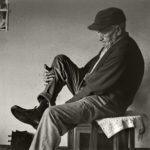
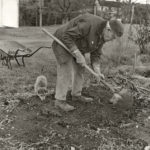
* * * * *
 Alex kept a small photograph of Magdelana, who died in 1966, on a front table in his living room along with her geraniums. Was he showing me something I could never know or thinking of earlier times with her in this house? Alex never made me feel like an intruder, but rather someone he wanted to share his time with. It took years for me to fully appreciate that simple expression. Acceptance.
Alex kept a small photograph of Magdelana, who died in 1966, on a front table in his living room along with her geraniums. Was he showing me something I could never know or thinking of earlier times with her in this house? Alex never made me feel like an intruder, but rather someone he wanted to share his time with. It took years for me to fully appreciate that simple expression. Acceptance.
* * * * *
 Born in Lithuania, Alex left his country to avoid conscription into the Tsar’s army during the Russo-Japanese War of 1904. He walked westward some 500 miles and shipped out to Boston where he lived until the Depression. In the early 1930s, he and his wife bought the 40+ acres in Norfolk where his seven children were raised. His kids had all left the farm by the time I lived in the small house that had originally been Alex’s. One time, when his children weren’t available, I took him to a picnic for Lithuanian immigrants. I regarded Alex as the grandfather I never had. He enjoyed having his picture taken. It was a collaboration. Because he was almost deaf, there wasn’t a lot of small talk between us. But our experiences together had a profound density. I remember feeling compelled to keep shooting, and I did so every day. It was as if I had just been skimming the surface of things until I lived on his land.
Born in Lithuania, Alex left his country to avoid conscription into the Tsar’s army during the Russo-Japanese War of 1904. He walked westward some 500 miles and shipped out to Boston where he lived until the Depression. In the early 1930s, he and his wife bought the 40+ acres in Norfolk where his seven children were raised. His kids had all left the farm by the time I lived in the small house that had originally been Alex’s. One time, when his children weren’t available, I took him to a picnic for Lithuanian immigrants. I regarded Alex as the grandfather I never had. He enjoyed having his picture taken. It was a collaboration. Because he was almost deaf, there wasn’t a lot of small talk between us. But our experiences together had a profound density. I remember feeling compelled to keep shooting, and I did so every day. It was as if I had just been skimming the surface of things until I lived on his land.
In 1973, on learning that Alex was in the hospital, I paid a visit. He asked, “Did you bring your camera?” I took a few photographs. The next day, Alex died. Maybe it’s as simple as … there’s something absolutely perfect about the days I spent near and with him. There are some images of him that I can’t get a handle on. The archive is still alive for me. There are so many pictures, and too many ways to group them to tell the story. But my hesitation arises from more than the subject itself. Alex was a role model for me – and I’ve never felt that I’ve lived up to his standards for independence and resourcefulness. Competence and consistency. The unfinishing is a lifelong self-assessment.
Alex’s death, while representing a conclusion to the photographs, never offered closure for me personally. Endings seem not only arbitrary, but illusory. To believe that something has ended, you have to imagine it as such. Such imagining has been impossible for me when it comes to my brief time on Alex’s farm. I simply could not move forward on editing the photos, preparing the best prints, and moving toward showing them. Is this an incapability on my part? Or was that one year of shooting photos of Alex a portal to the world, an education in seeing and loving the light that is the foundation in my art, my life?
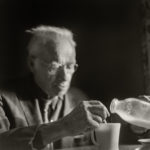
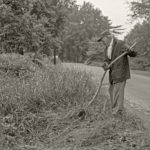
* * * * *
And yet, and yet … Every so often I would return to the files and digitize some of the images. One day, I came across a photo that Alex had taken of me – a contemplative moment in front of his old Dodge. I had set up the camera on a tripod and then stepped out in front of the lens for some reason – and he simply looked through the viewfinder and pushed the shutter release. Then he tacked that print up on his wall. That gesture got to me, deeply. There were never moments of spoken intimacy between us, but many days marked by mutual care.
* * * * *
My paternal grandfather, for whom I was named, died four years before my birth, and my maternal grandfather 11 years before. The only grandparent I knew was my maternal grandmother who died when I was six years old.
My father was famously resourceful and self-sufficient. He invented, designed, built and repaired machines big and small. But his work poisoned him: he died before he could impart those skills to me. Yet I always have felt an affinity with my father’s attributes, even if I have only aspired to them. When I’m most harshly critical of myself, I say that my ignorance and arrogance have expedited me more or less successfully through life.
Maybe I saw in Alex not just the grandfather I never had, but the father I always longed to be mentored by.
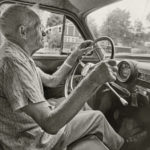
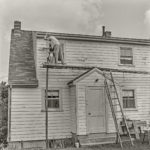
Having graduated from college, the prospect of working as a photographer, commercially and for the art, seemed attractive to me. But I never apprenticed or took formal training, never sought out a mentor. I attribute this to both ignorance and arrogance. A great teacher in the arts will not only instruct in technique but provide a model for living as an artist. So during my time with Alex, I experimented with different cameras, from large 4×5 view cameras and fixed super-wide cameras to a small 35mm Leica and even a Bolex for shooting 16mm movies.
I installed a darkroom in a converted pantry at the back of my house, but I can’t recall how I got water plumbed in. What I can say is that the water was unfiltered — since I didn’t know then that filtering is essential for unblemished prints. It wasn’t until I started digitizing the negatives in 2019 that I realized how dirty the water was. When the images are increased in size, the water spots appear as huge. As I continue to discover more images of Alex in my files, I painstakingly clean each one. It’s tedious but gratifying work.
I experimented with different types of film, both large and small format, from high sensitivity to superfine grain. And then there were various kinds of developers, concentrations and filtrations. My approach was rather haphazard — but it turned out to be a good way to evaluate many outcomes. The point of all this is — as I pore through the countless images, I see an experiential record of a photographer in self-training. But this occurred not because I’m such an avid self-starter. The images also reveal to me how Alex’s daily, disciplined approach to his property and farm set an example that I could hardly ignore.
Anticipation for him was a mode of maintenance. But also, preparation. I remember Alex planting strawberries that spring and mentioning that since the new plants take two years to bear fruit, he might not even get to taste the strawberries.
The images have so many qualities and quirks from all the experimenting, photographically speaking, that I haven’t yet arrived at an organizing principle for showing the work in book form or for a showing. For instance, the first images of Alex, taken with a view camera on a large tripod, are the most detailed and fine-grained. They may also be the least dynamic and revelatory.
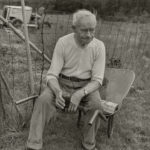
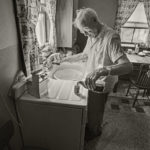
* * * * *
Alex grew corn, and I was inspired to put in some plants of my own. As my corn grew, so did my marijuana plants, hidden between those rows. One day in the early fall of 1970, my dog Atticus went chasing after Alex’s hens which had escaped their fenced-in space – and Alex’s son, employed as a guard at the nearby MCI-Norfolk Prison, went after the dog. This is how he discovered the thriving pot harvest. He reported his findings to Alex’s grandson, a local cop, who arrived soon after to bust me.
 I was arrested for possession of pot. A search warrant was presented, and the police carried off our other “narcotics” – cough medicine, various meds, even my cousin’s Darvon pills. Alex told me, with child-like amusement, that in all the years of his farming, the police had never cared to photograph his garden.
I was arrested for possession of pot. A search warrant was presented, and the police carried off our other “narcotics” – cough medicine, various meds, even my cousin’s Darvon pills. Alex told me, with child-like amusement, that in all the years of his farming, the police had never cared to photograph his garden.
Earlier, Alex had tipped me off that the police had come by to examine my garden, take samples, and shoot pictures of the plants. I then pulled up the plants, but to no avail.
The authorities told me that charges would be dropped if I left town and stayed out for good. Not the worst ending for a frightening run-in with the law that made front page news.
Alex and I stayed in touch by mail after I left. I moved to Beverly, MA, north of Boston and 50 miles from Norfolk. Despite the embargo, I made periodic trips back to visit. He always lit up when I arrived.
I visited Alex for the second to last time in the spring of 1973. It was a shock to find him enervated, this man who even in his 80’s could be found high on a ladder painting the side of his house. He was listless yet receptive to my visit. I took a photo of him sitting back in his chair, his long arms outstretched as if trying to grasp the air.
 The next time I came to visit, several weeks later, he was not at home.
The next time I came to visit, several weeks later, he was not at home.
I inquired as to his health and whereabouts with his daughter and was informed that he had been admitted to the Pondville State Hospital
I went to visit him there and took my last photos of him.
He was alone in the room, in bed and silent. But he soon recognized me and asked if I had my camera. I said “yes” and he asked, “Are you going to take my picture?” He said he had been waiting for me.
I took just three frames of film. The last.
He died the next morning, I was told. The family neglected to inform me of his death and burial, maybe understandable given the circumstances of my exile.
It was perhaps fated that I should have chosen the day before his passing to make that final trip to Norfolk to see him.
* * * * *
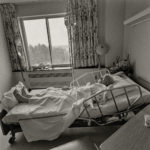
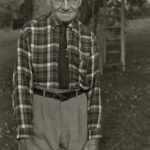
This final image is one of the first pictures I made of Alex Waitkevitch.
He wore his Sunday best, standing against a tree in his front yard. For this initial photo, for which I asked him to pose, his shirt, tie and belt were all tucked in, hair combed. I can see now that this was an important event for him.
He had such long, impressive arms, with hands that related their histories.
It was a serious pose. He didn’t know much about this 23-year old kid with the imposing 4×5 inch view camera on a tripod. The taking of this picture, a moment of pause for both of us, was an opening. The rules of living are not abstract but formal – they are enacted through our actions. This is what I see in his posture. Formal, but not stiff. Alex, sitting for me, was showing me his receptivity to experience, and the experience of sitting for a formal photo on his own property was something entirely new and momentous.
My preference is to end this essay at the beginning.
Lovely, moving essay – gorgeous photos.
Great photos and story. I’ll say more in more detail very soon.
This was a beautiful tribute to my husband’s great grandfather. I found it very moving. Thanks so much.